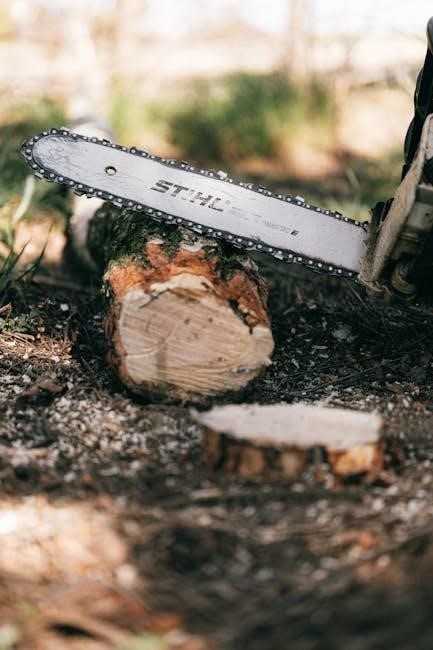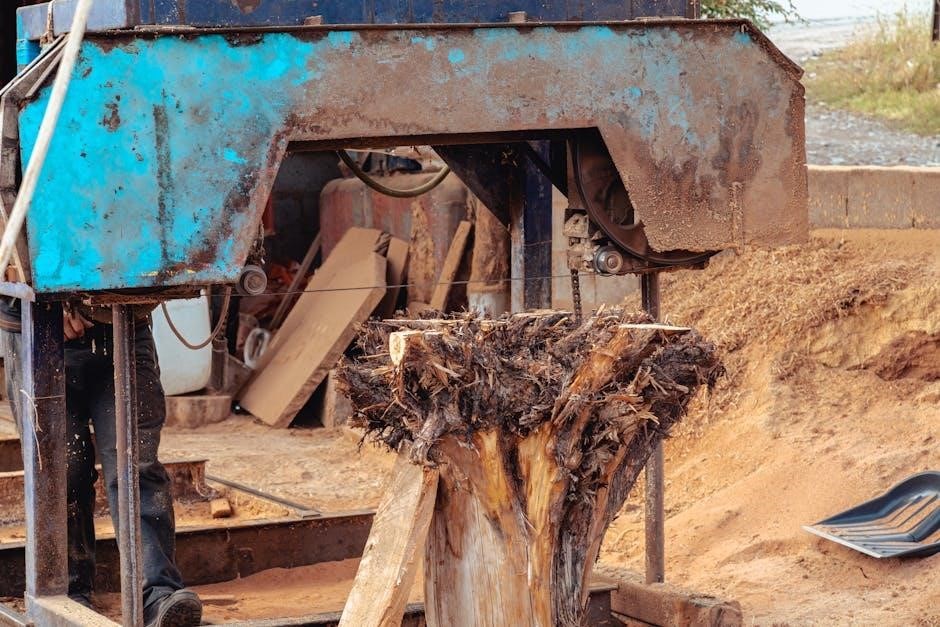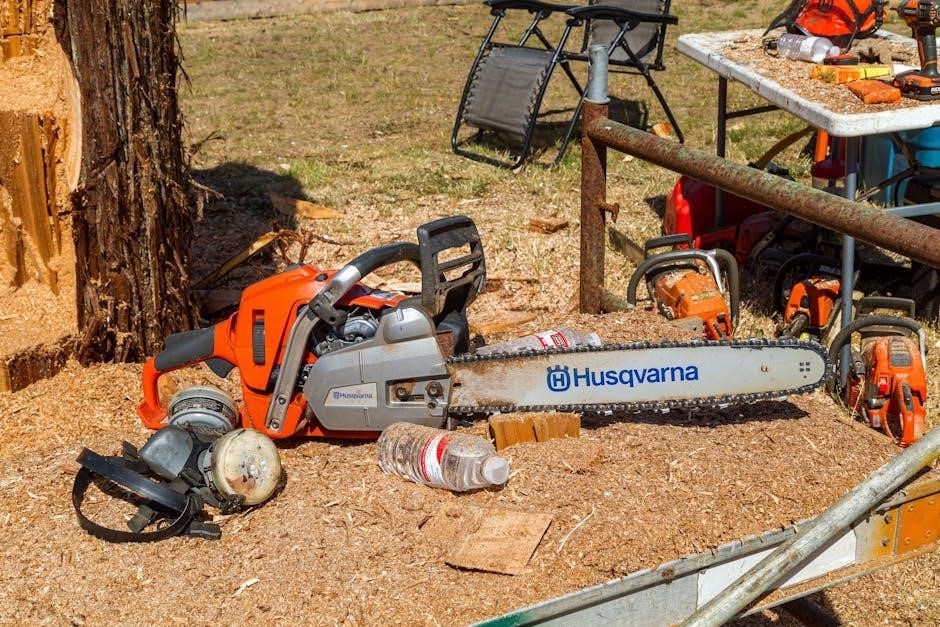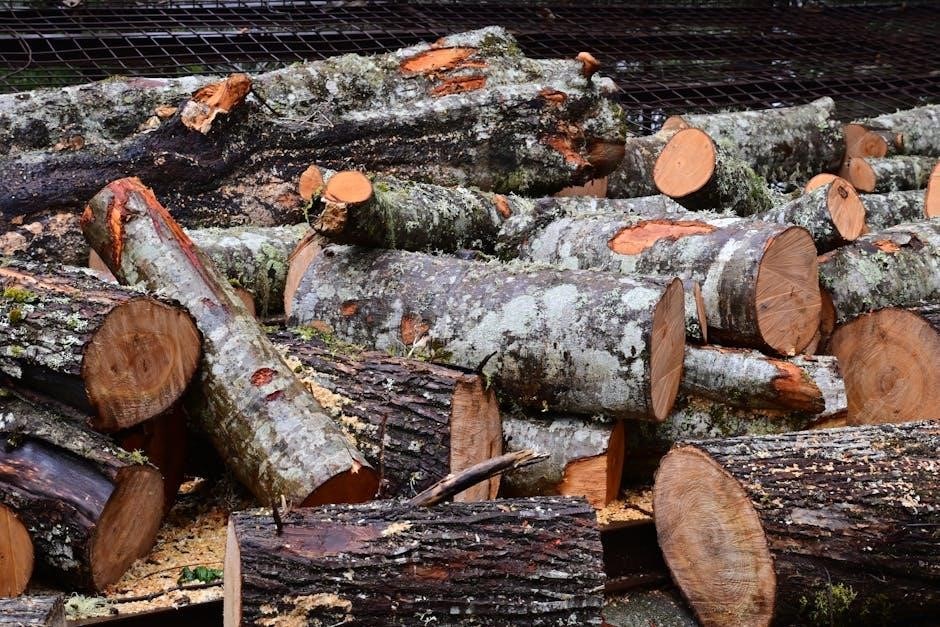A chainsaw sawmill is a portable, cost-effective tool for turning logs into lumber. It combines a chainsaw with a guide system for precise cuts, offering affordability and portability for DIY projects.
What is a Chainsaw Sawmill?
A chainsaw sawmill is a portable device that transforms a chainsaw into a functional milling tool. It consists of a guide system attached to the chainsaw, enabling precise cuts through logs to produce lumber. This setup allows for on-site milling, making it ideal for DIY projects and remote locations. The sawmill’s simplicity and affordability make it accessible for hobbyists and small-scale woodworkers, offering a cost-effective alternative to industrial machinery while maintaining versatility and efficiency.
Advantages of Using a Chainsaw Sawmill
A chainsaw sawmill offers portability, affordability, and versatility, making it ideal for small-scale woodworking projects. It allows milling directly at the log location, reducing transportation costs and effort. The setup is cost-effective compared to industrial sawmills, appealing to hobbyists and DIY enthusiasts. Its compact design enables milling in remote areas with minimal equipment. Additionally, it promotes sustainability by utilizing the entire log with minimal waste, making it an eco-friendly choice for crafting custom lumber and unique wood projects.
A Brief History and Evolution of Chainsaw Sawmills
The concept of chainsaw sawmills emerged in the mid-20th century, evolving from traditional logging techniques. Early designs were rudimentary, with chainsaws mounted on basic frames. The development of guide rails and sled systems in the 1960s revolutionized the process, enabling accurate cuts. Modern designs incorporate advanced materials and ergonomic features, improving efficiency and safety. Portable mills like the Alaskan sawmill have popularized the method globally, making it accessible for small-scale production and DIY projects, while maintaining affordability and versatility for various woodworking needs.

Setting Up the Sawmill
Setting up a sawmill involves constructing guide rails and support structures, then attaching the sled and chainsaw. This ensures stability and accuracy for milling.
Guide Rails and Support Structures
Guide rails and support structures are essential for stabilizing the sawmill. Typically made from steel or aluminum, these rails provide a flat surface for the sled to slide along. Supports are placed under the log to maintain balance and prevent movement during cutting. The rails must be level and securely attached to ensure accurate cuts. Proper setup involves building or attaching these components to the log, creating a sturdy base for milling. This system is crucial for achieving consistent results and preventing warping or uneven cuts.
Sled and Chainsaw Attachment
The sled is a crucial component that holds the chainsaw securely and allows it to move smoothly along the guide rails. Constructed from durable materials like steel, the sled ensures stability and precision during cutting. The chainsaw is attached to the sled using clamps or brackets, which must be tightened firmly to prevent any movement. A well-designed sled enables consistent cuts and efficient milling. Proper alignment and attachment of the chainsaw to the sled are essential for achieving accurate results and ensuring safety during operation.

Achieving Accurate Cuts
Achieving accurate cuts requires precise guide rail alignment and proper sled attachment. These elements ensure consistent thickness and straight cuts, enhancing overall milling efficiency and lumber quality effectively.
The Role of Guide Rails in Thickness Control
Guide rails are essential for maintaining consistent lumber thickness. They provide a stable reference point for the chainsaw sled, ensuring each cut aligns perfectly with the previous one. By setting the rails to the desired width, users can achieve uniform planks. This system minimizes human error and ensures accuracy, especially when processing large or hardwood logs. Properly secured rails also prevent wobbling, contributing to straight, even cuts. Regularly checking and adjusting the rails is crucial for optimal results in milling operations.
Tips for Maintaining Consistency
To maintain consistent cuts, ensure guide rails are securely attached and aligned with the log. Regularly check and tighten the sled attachment to prevent movement. Always use a sharp chain, as dull blades can lead to uneven cuts. Keep the chainsaw properly tensioned and lubricated for smooth operation. Preparing the log surface evenly and marking the desired thickness beforehand also helps. Finally, maintain steady, controlled movements throughout the cutting process to achieve uniform results and avoid waste.

Essential Plans and Designs
Essential chainsaw sawmill plans often include DIY designs for guide rails, sled attachments, and customizable jigs. These plans emphasize accessibility and ease of construction for homemade setups.
DIY Chainsaw Mill Plans
DIY chainsaw mill plans are popular for their affordability and accessibility. Many designs, like the Granberg Alaskan mill, offer step-by-step guides for constructing a portable sawmill. These plans often require basic materials such as steel for guide rails and a sled to attach the chainsaw. Free online resources provide detailed instructions, emphasizing the importance of precise measurements and a sturdy frame. Homemade mills allow users to process logs into lumber on-site, making them ideal for small-scale projects. Ensure your plan includes safety features and consider chainsaw size for optimal performance.
Designing a Custom Milling Jig
Designing a custom milling jig involves creating a tailored sled or frame to hold your chainsaw, ensuring precise control. Start by determining the jig’s size based on your chainsaw bar length and the logs you’ll mill. Use durable materials like steel for the frame and include adjustable clamps for secure attachment. Incorporate guide rails or a roller system to maintain alignment during cuts. Custom jigs can be modified to accommodate different log sizes or unique cutting needs, enhancing versatility for various projects. Always prioritize stability and safety in your design to achieve accurate results.

Safety Precautions and Best Practices
Ensure proper guide rail setup, secure sled attachment, and use chainsaws with adequate power for milling. Always maintain equipment and follow safety guidelines to avoid accidents.
Safety Tips for Milling
Always ensure the guide rails are properly secured and the sled is tightly attached to the chainsaw. Wear protective gear, including gloves, safety glasses, and a helmet. Never mill near loose clothing or long hair. Keep bystanders at a safe distance and avoid distractions. Regularly inspect the chainsaw and milling setup for damage or wear. Maintain a clean workspace to prevent tripping hazards. Follow proper techniques to avoid kickback, and always cut on a stable, level surface. Proper safety practices are essential for accident-free milling.
Maintenance and Chainsaw Care
Regular maintenance is crucial for optimal performance and longevity of your chainsaw sawmill. Inspect the chainsaw bar and chain daily, sharpening or replacing them as needed; Clean debris from the guide rails and sled to ensure smooth operation. Lubricate the bar and chain frequently to reduce wear and prevent overheating. Store the chainsaw and milling equipment in a dry, protected area when not in use. Proper care extends the life of your equipment and ensures consistent, high-quality cuts.

Choosing the Right Chainsaw
Selecting the right chainsaw is crucial for milling. Opt for a chainsaw with a minimum 70cc engine and a 20-inch bar for optimal performance and durability.
Chainsaw Specifications for Milling
For milling, a chainsaw with a minimum 70cc engine and a 20-inch bar is recommended. Ensure the saw has enough horsepower to handle thick logs efficiently. A full-chisel or semi-chisel chain is ideal for smooth cuts. The chain must be sharp and properly tensioned to maintain control and avoid kickback. A longer bar length allows for deeper cuts, while a shorter bar offers better maneuverability. Consider the weight and ergonomics for extended use. Proper chain type and bar length are critical for safe and effective milling operations.

Advanced Milling Techniques
Master techniques for milling large logs and creating perfectly dimensioned lumber. These advanced methods ensure precision and efficiency in woodworking projects.
Milling Large and Hardwood Logs
Milling large and hardwood logs requires precision and patience. Use a chainsaw with sufficient power, typically 70cc or higher, to handle dense materials without overheating. Sharp chains are essential for clean cuts. Guide rails help maintain stability, while controlled, steady pressure ensures even results. For hardwoods, slower, deliberate cuts prevent binding. Proper log orientation and alignment are critical for achieving desired dimensions. This method allows you to transform challenging logs into valuable, custom lumber, perfect for furniture or construction projects.
Creating Perfectly Dimensioned Lumber
Producing perfectly dimensioned lumber begins with accurate guide rail setup and consistent cutting techniques. Measure and mark logs precisely before milling. Use a chainsaw sled or jig to maintain uniform thickness across cuts. Regularly check and adjust the saw’s alignment to avoid deviations. Sharp chains are crucial for clean, straight cuts. For each subsequent cut, reference the previous one to ensure uniformity. This method allows you to achieve professional-grade lumber, ideal for woodworking projects, while minimizing waste and maximizing material quality.

Troubleshooting Common Issues
Troubleshooting common issues involves addressing misalignment, uneven cuts, and chain veering. Check guide rails and sled attachments to ensure secure, proper alignment and squareness for accurate milling.
Addressing Alignment and Cutting Problems
Misalignment and uneven cuts are common issues in chainsaw milling. Check guide rails for proper installation and ensure the sled is securely attached. Uneven cuts often result from improper chain tension or inconsistent pressure. Regularly inspect and tighten all bolts and connections. If the chain veers, adjust the guide rail alignment or consider using a spirit level to ensure the sled moves smoothly. Properly aligned rails and consistent sled movement are key to achieving accurate cuts and maintaining lumber quality. Regular maintenance and adjustments will help minimize these challenges.

Creative Projects and Applications
Transform logs into custom furniture, decorative slabs, and unique woodwork. Chainsaw sawmills enable crafting personalized items, from live-edge tables to artistic wood sculptures, unlocking creativity in woodworking projects.
From Slabs to Furniture
Transform raw wood slabs into stunning furniture pieces using a chainsaw sawmill. Start by milling logs into smooth, even slabs, perfect for creating live-edge tables, countertops, or shelves. Add a personal touch by carving intricate designs or leaving natural imperfections intact. With proper seasoning and finishing, these slabs become durable and beautiful additions to any home. Consider crafting decorative wall art, coasters, or other small items to maximize creativity. This process allows you to preserve the natural beauty of the wood while creating functional and unique pieces for your space.
Unique Applications and DIY Ideas
Explore beyond traditional woodworking with a chainsaw sawmill. Create live-edge slabs for wall art, coasters, or decorative accents. Transform large logs into custom firewood or tool handles. Use hardwoods for durable outdoor furniture and softwoods for intricate carvings. Experiment with layered designs by combining different wood types. Build unique birdhouses, planters, or even custom axe handles. The versatility of milled lumber opens endless possibilities for creative and functional DIY projects, allowing you to craft one-of-a-kind items tailored to your needs and preferences.